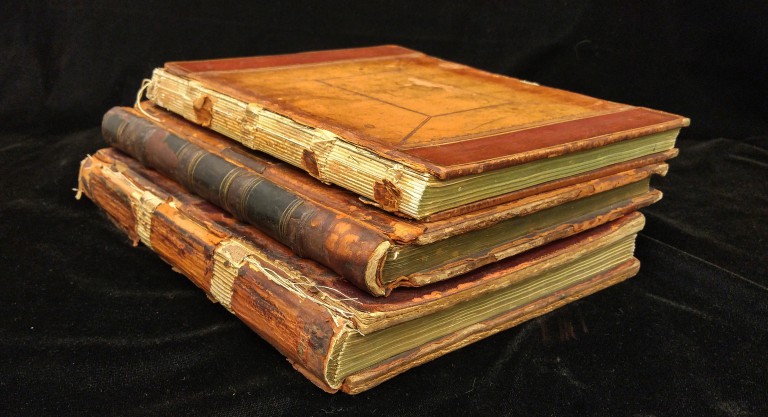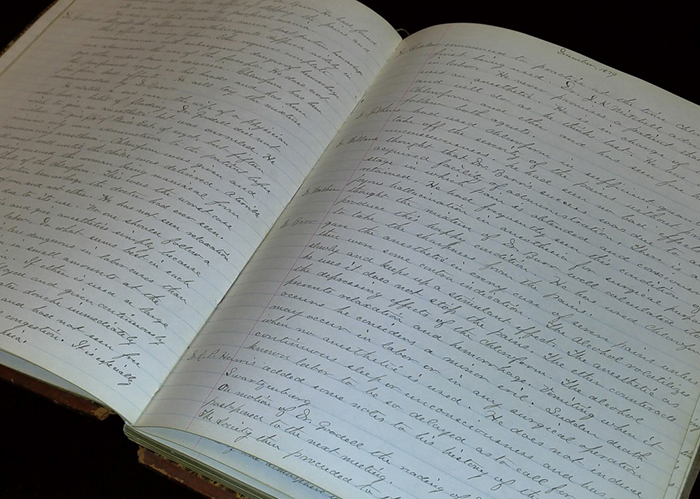On the Evolution of Meeting Minutes: Formality and Degrees of Richness
-by guest blogger, intern Jessica Walker
Though to some meeting minutes may seem routine, and perhaps even mundane, that is precisely why they are so fascinating. Minutes are found within most organized groups, allowing for a common format to compare across time, distance, and even topic.
The Obstetrical Society of Philadelphia was founded in 1868 as an educational organization for those who were interested in “the diseases and problems particular to women.”1 Of particular interest within this collection is the minutes of the Society, which contain a range of detailed descriptions of meetings as well as parliamentary procedure followed by the organization. As all things do over time, the Society evolved, and the changes in the structure and leadership of meetings are reflected within the meeting minutes of the Society.

Bound volumes of meeting minutes
Physically and intellectually, the meeting minutes and documents undergo a significant transition from the founding of the Society to present. The early minutes, ranging from 1879 to 1923, were hand written in bound (unpublished) volumes. They contain detailed dialogues, recording a paraphrase of who said what and on what topic. Dialogues and discourses taking place during the meetings included topics such as a woman who gave birth to five children in one year around 1880 or a case where the umbilical cord was wrapped around the neck of an infant and the results of such.

Minutes from a meeting dated December 1879
From the minutes, we can tell that each meeting dedicated significant time to case studies, autopsy specimens, and discussion, which reveal fascinating insights into the minds of medical professionals of the day. It is because the minutes are so detailed that we are better able to interpret what a doctor may have meant when they used a particular phrase, or why a certain topic may have come up. The observations provided by these minutes allow for valuable examination of changing medical thought, interests, and priorities up to the 1920s.
The minutes from the 1920s to 2009 thoroughly cover what happened during the meetings, but do not contain the depth of discussion as the early minute books. Later meeting papers offer more formal, parliamentary procedure style minutes, as many meeting records seem to do. Although these types of minutes are still extremely useful in tracking what organizations were talking about at any given point in time, the uniqueness of an organization seems to be lost when parliamentary style minutes take over. Per usual, the meeting was opened with the reading of previous meeting minutes, which then flowed into the “scientific program” portion of the meeting, followed by “private business” (consisting of reports on membership and committees), and closed with new and/or unfinished business.

122 years later, meeting minutes from May 2001
Of particular interest in this portion of the meeting minutes is the detailed topics covered during these scientific programs. Speakers presented papers on topics such as laparoscopic surgery or pregnancy following the amputation of the cervix, as well as hosting events where several speakers discussed broader topics, such as sexual education. As interesting as the topics are, often what we learn from the minutes is that they happened, but not what the response was. Fortunately, the Obstetrical Society did record some of these scientific sessions, and some of the recordings are preserved at the Legacy Center Archives.
From founding to present, the meeting minutes of the Obstetrical Society of Philadelphia have had some aspect of parliamentary procedure woven into the meetings. However, it is when procedure begins to take precedence over content that the individual voices of an organization can become muffled in the meeting minutes. Though the minutes of the Obstetrical Society of Philadelphia vary in depth and detail over time, they allow for a comprehensive look into the functioning of a medical society. Minutes describe what is going on in an organization at any given time in varying degrees of detail, and often reflect the changing nature, order, and leadership of an organization. This particular society is an excellent example.
1“Constitution and bylaws.” (1998) Box 1, Folder 5, The Obstetrical Society of Philadelphia records, 1868-2015, Drexel University College of Medicine Legacy Center Archives.